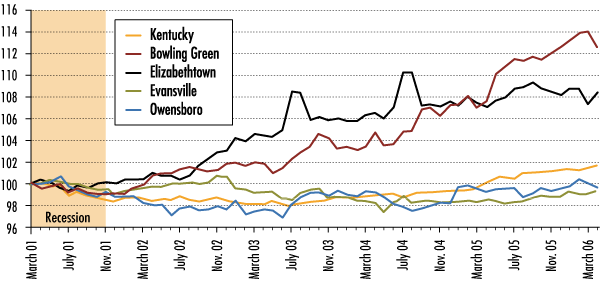District Overview: Uneven City Job Trends Weigh on Kentucky's Recovery
The metropolitan statistical areas (MSAs) of Bowling Green, Elizabethtown, Evansville and Owensboro all experienced a decline in payroll employment during the latest recession, which lasted from March 2001 to November 2001. Since the end of the recession, only two of those four MSAs have recovered from their recessionary job losses, though those two have experienced significant employment growth.
As seen in the chart, Bowling Green and Elizabethtown recovered their recessionary job losses within six months of the recession’s end and have since experienced considerable employment growth. Employment in Evansville rebounded by July 2002 to its pre-recession level but then dropped below the recession level in January 2003 and remained below that level through April 2006 despite a modest increase in the past year. Owensboro’s employment continued to fall after the recession until July 2003. Employment then started to rise, exceeding the pre-recession level for the first time in February 2006 but falling below pre-recessions levels again in April 2006.
Employment in the state of Kentucky rose above its pre-recession level in April 2005 and continued to increase through April 2006. Total employment in Kentucky in April 2006 was roughly 1.5 percent greater than its pre-recession level and nearly 3 percent greater than its recession level.
Of the four MSAs, Bowling Green has experienced the largest post-recession employment gain. From November 2001 to April 2006, total payroll employment increased by 13 percent. While one-fifth of Bowling Green’s employment increase occurred from April 2005 to April 2006, its rate of total employment growth in those 12 months was half of its total employment growth in the previous 12 months. Despite a drop in April 2006, employment growth since April 2005 is attributed to a 5 percent increase in manufacturing employment, as well as a 5 percent increase in employment in professional and business services and a 6 percent increase in leisure and hospitality over the same time period. While trade, transportation and utilities employment dropped 2.5 percent during this same period, this decline was tempered by a 1.5 percent increase in education and health services employment.
Elizabethtown has had notable post-recession growth as well. April 2006 employment was 8 percent greater than employment in November 2001. However, employment growth has been trending down since August 2005, and April 2006 employment remained virtually unchanged from April 2005 employment levels. Contributing to the stagnant employment growth are unchanged employment levels in manufacturing and the leisure and hospitality sector from April 2005 to April 2006. Employment in education and health services increased 2 percent over those 12 months after remaining unchanged in the previous 12 months, and trade, transportation and utilities employment rose 1 percent after a nearly 5 percent decline 12 months earlier. However, these improvements could not offset the slowing of the professional and business services sector to a 2.5 percent rate of growth after growing 14 percent in the previous 12 months.
After a period of steady decline, total employment in the border town of Evansville, Ind., returned to its November 2001 level by March 2006. April 2006 employment stood less than 1 percent below its pre-recession level. While Evansville’s employment growth slowed from April 2005 to April 2006, employment remained on the rise. Evansville experienced a 2.5 percent increase in leisure and hospitality employment during those 12 months as well as a 3 percent increase in professional and business services employment. A 2 percent increase in employment in education and health services offset a less than 1 percent decrease in manufacturing. Employment in the trade, transportation and utilities sector remained unchanged.
Since November 2001, total employment in Owensboro has grown by a half-percent. In the 12 months starting April 2005, the growth rate also increased by a half-percent, placing the April 2006 level of total employment just below pre-recession levels. A majority of Owensboro’s growth from April 2005 to April 2006 can be attributed to a 4 percent increase in employment in the leisure and hospitality sector. A 2 percent increase in employment in education and health services offset the 2 percent decline in manufacturing. Employment was unchanged in the professional and business services sector and in the trade, transportation and utilities sector.
Views expressed in Regional Economist are not necessarily those of the St. Louis Fed or Federal Reserve System.
For the latest insights from our economists and other St. Louis Fed experts, visit On the Economy and subscribe.
Email Us


